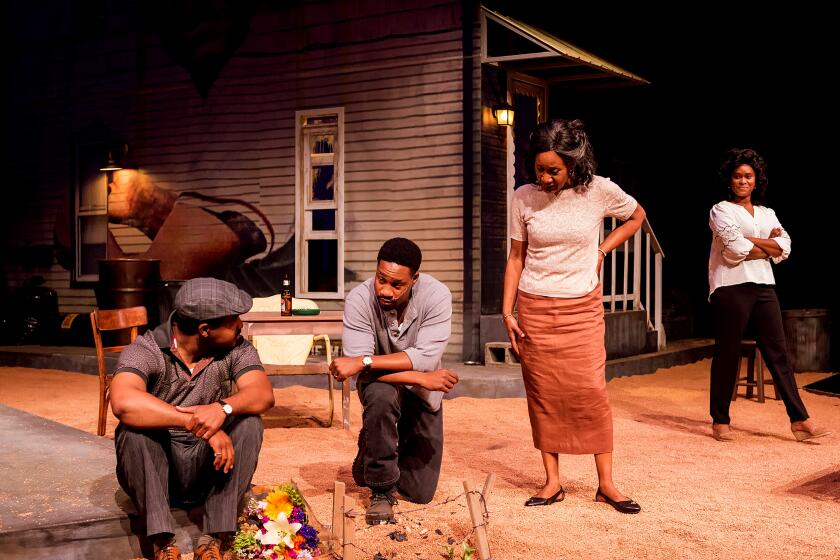Wrecking Ball Casts Shadow on Arts Colony in Beijing
Painters, sculptors and photographers in Suojiacun, an artists’ village in a rundown section of northeast Beijing, thought they had found their spiritual home. The 100 or so loft-like spaces, built to their specifications, offered expansive room to work, relatively low rent and sizable gardens where residents could tackle more ambitious art projects.
Perhaps most important, the site had critical mass, attracting artists from around China and abroad to the 7-acre compound and fostering a creative environment they called second to none.
On Nov. 14, however, police informed the landlord that the colony would be leveled within 24 hours. The following day, police arrived at 8 a.m. with several moving trucks and an ambulance, smashing walls in a portion of the complex, carting off furniture and scattering possessions.
As they left, officers warned the remaining tenants that their places would suffer the same fate within 10 days.
“It’s a case of killing the chicken to scare the monkey,” said Xing Danwen, a contemporary artist who incorporates circuit boards and broken cellphones into her works, citing an old Chinese expression about using fear to set an example.
The destruction followed a clash in June, when the government threatened to tear down Suojiacun on the grounds that it lacked the proper permits. A public outcry prompted the government to back off then, tenants say. Their understanding was that authorities would allow a yearlong grace period while legal issues were being resolved.
Beijing is no stranger to the wrecking ball. Hutongs, or alley neighborhoods, are being destroyed at a furious pace in the 3,000-year-old city’s thirst for modernity and global prestige. The capital will play host to the Summer Olympics in 2008.
Nor are disputes over land use, ownership and building permits unusual in a country that still officially has no private property, where the law is a movable feast and rights are often only as good as one’s connections.
But artists at the colony say they believe something else is at play. Even though they acknowledge that the developer may have taken some shortcuts, the artists suspect that the lofts’ creative residents also are being targeted on ideological grounds, at a time when authorities are cracking down on the media, Internet essayists, nongovernmental organizations and scholars.
“Official government-approved artists have no problem,” said Zhang Jianhua, 36, a sculptor who produces life-size likenesses of disenfranchised migrant workers and impoverished farmers.
“Since Mao’s day, art was supposed to serve the government. But contemporary art is critical of contemporary society and often seen as subversive,” Zhang said.
Shanghai is China’s city on the hill, a bastion of modern architecture and fast-paced moneymakers that appeals to most foreigners. Beijing is a frumpier city that seems stiff and formal on the surface. But it is also the artistic heart of China, many say, a melting pot for creative types.
And in the endless debates about the relative merits of these two rival cities, the capital’s supporters say the biggest difference is that Beijing has soul. Discourage artists, they add, and the city will lose something fundamental.
The artists say that instead of encouraging this community with its potential to boost Beijing’s global standing -- and its real estate values -- the government at best barely tolerates them, leaving them constantly on edge over the fate of their studios.
“Artists have come to the capital from all over China to share the dream of art,” said Shan Juan, who runs a gallery in the city. “What the government is doing is tearing at their hearts. Adding to the situation, art still doesn’t have that much understanding among the Chinese public.”
Yuanmingyuan, another artists’ community, was leveled several years ago. And even people at Factory 798, Beijing’s most famous network of galleries established in a sprawling former military complex, have little assurance that the more established facility won’t be torn down.
Artists in the Suojiacun complex, dubbed “Beijing International Art Camp,” have tried to attract media attention in a bid to save what remains of the community.
They have also tried to voice their frustration through their work. They staged a final exhibition late last month entitled “Exodus -- Made to Move” that included photographs of the destruction. And performance artist Liu Bolin, 33, spent hours in the cold on a recent day being painted by a friend to look like one of Suojiacun’s red brick walls in preparation for a quiet individual protest.
But the artists say the government’s preemptive strike has left them little time to organize. Furthermore, popular opposition rarely stops construction crews for long in China, particularly when they’re backed by government agencies.
“Artists in China don’t have much voice, almost like farmers or migrant workers,” said Zheng Xuewu, editor of a book on the works of Suojiacun residents. “What can we do? We don’t produce grain or make machines at a time when all China thinks about is economic development. They have an idea they want culture, but they aren’t sure how far they want to go.”
Many residents invested substantial sums in their studios, expecting to stay for a decade or longer, perhaps somewhat naively believing they had found a quiet shoal in Beijing’s chaotic property churn.
Jin Nan-Oh, a South Korean-born resident of Beijing who specializes in traditional Chinese ink drawings, surveys the 20-foot ceilings, potted palm tree and skylights of his studio as his dog walks over one of his paintings.
“I’ve put $17,000 into this place. I’ll never find another one like this,” he said. “I’m very upset.”
As they consider their options, many of the painters and sculptors say they’re still in the dark about what went on behind the scenes.
The local ward reportedly approved the plans for the artists’ community and viewed it as a welcome addition in this area of rundown shacks, dirt roads and piled-up garbage. But the Beijing municipal government apparently overruled local officials, pulling back the welcome mat.
Some suspect a clash between different arms of government. Others believe that the developer didn’t provide enough “tea money,” or bribes, to the right people, or perhaps gave it to the wrong faction, prompting a strong reaction by those left out. Still others blame the developer for misrepresenting the terms and failing to inform residents of the potential legal problems.
Officials with the local and municipal government declined to comment, as did the developer.
“I don’t know where I’ll be going next,” said Yu Shengwen, an oil painter warming his hands over a bonfire of broken picture frames and splintered beams. “It’s impossible to find another place like this. I’ll stay as long as I can. I’ll wait till the bulldozers come.”
*
Yin Lijin in The Times’ Beijing Bureau contributed to this report.
More to Read
Start your day right
Sign up for Essential California for news, features and recommendations from the L.A. Times and beyond in your inbox six days a week.
You may occasionally receive promotional content from the Los Angeles Times.






